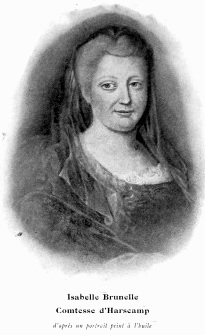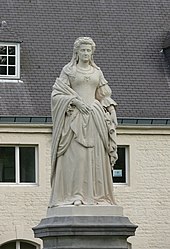Maria Isabella d'Harskamp
Maria Isabella Countess d'Harskamp (s) (born September 3, 1724 in Aachen ; † May 8, 1805 Aachen) was a philanthropist . She established foundations in Namur and Aachen. She was born as Maria Isabella Brunelle , daughter of the landlords Hermann Brunelle and Jeanne-Marie Tilmans in Aachen.
Life
In 1748 Count Pontian d'Harscamp came to Aachen for a cure. He was a wealthy man with possessions in Namur , Liège , Bohemia and Hungary . His family was originally from the Netherlands, but that branch had died out 50 years earlier. The Graf was the last of his line. He was a colonel in the service of the Electorate of the Palatinate and on the way to his estates in Hungary when he stopped by the landlords. He took his daughter Isabella with him to Hungary and married her in September of the same year in Kniesen . The couple lived on their property and had 3 children who died in the smallpox epidemic in 1763 (the last in 1765). The couple then returned to Namur and initially lived at Fernelmont Castle . In 1772 they bought the Marchin estate . The rich and benevolent countess was famous and even met Emperor Joseph II on June 5 and 6, 1781 , when he stopped briefly in Namur.
From 1787 unrest broke out across the country, caused by the reforms of Joseph II and the French Revolution . When the Austrians were defeated in the Battle of Jemappes on November 6, 1792 , the Belgian territories fell to the French. On November 20th, the Namur fortress was occupied. Only one year later, on March 18, 1793, the French lost in the Battle of Neerektiven and had to evacuate the Belgian territories. On March 26, 1793, the imperial family were back in Namur. On June 25th, 1794 the French won in Fleurus and the Austrians had to withdraw again.
In this back and forth the count died on May 1, 1794 and was buried in the cemetery of Noville-les-Bois (today a district of Fernelmont). In his will he made many donations for the poor in the area. On June 1, the countess fled to Hesse. Your goods in Belgium were initially confiscated. But she was able to sell her possessions in Bohemia. But she died unexpectedly for everyone on May 8, 1805 in Aachen.
In her will of January 29, 1805, she established numerous foundations for the poor. In addition to regular bread donations (from the Allgemeine Deutsche Biographie ), this included :
- an annual pension of 3600 francs for the poor in Aachen,
- 7,200 francs pension to support the shameful poor of impeccable change, whose parents or ancestors had lived in prosperity,
- 3600 francs pension to support twelve young girls for their training; they had to be at least 14 years old and, if they were well managed, they would remain in possession of the support until they were married or otherwise provided for
- a pension of 6,000 francs to support twelve boys aged 12 to 21.
In 1868 the Harscamp Foundation in Aachen had assets of 230,000 thalers and in 1901 15,458 gold marks. On January 1, 1967, the foundation was dissolved and the existing assets flowed into the city's poor fund, which today still benefits the Aachen youth and elderly welfare, politically or religiously persecuted people, the welfare system, the German Child Protection Association and the Diakonie .
In Namur, the foundation money was invested in property and still exists today.
family
The countess had been married to Pontian d'Harscamp since September 3, 1748. The couple had the following children who all died of smallpox .
- Wenceslas Stanislas (October 29, 1751 - July 2, 1763)
- Franz Joseph (December 4, 1758 - July 12, 1763)
- Daughter (1759–1765)
Honors
In Aachen, Harscampstrasse is reminiscent of the Countess, in Namur, the Boulevard Isabelle Brunell ; one of its side streets is also called Rue d'Harscamp .
In the garden of the old hospice in Namur there is a statue of Maria Isabella d'Harskamp, which is by the Belgian sculptor Willem Geefs (from 1872). The Église Notre-Dame d'Harscamp also belongs to the hospice .
literature
- Friedrich Haagen: d'Harskamps, Maria Isabella Countess . In: Allgemeine Deutsche Biographie (ADB). Volume 10, Duncker & Humblot, Leipzig 1879, p. 646 f.
Web links
- La Fondation d'Harscamp
- Archive of the month September 2017 , on the website of the City of Aachen / City Archive Aachen
| personal data | |
|---|---|
| SURNAME | Harskamp, Maria Isabella d ' |
| ALTERNATIVE NAMES | Brünelle, Maria Isabella (maiden name); Harskamps, Maria Isabella d ' |
| BRIEF DESCRIPTION | Countess d'Harskamp and philanthropist |
| DATE OF BIRTH | September 3, 1724 |
| PLACE OF BIRTH | Aachen |
| DATE OF DEATH | May 8, 1805 |
| Place of death | Aachen |

